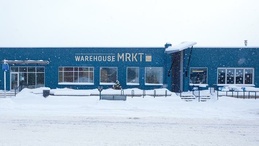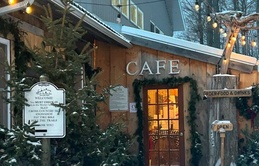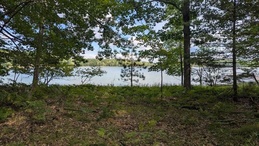Bill Pierce
July 19, 2009
Bill Pierce: The Problem SolverHow a low-tech water filter is saving lives in the Third World
By Anne Stanton 7/20/09
Bill Pierce leads a quietly exciting life. But you might not get that
right away.
He’s pretty much a normal looking middle age guy—short and stocky with
white hair and a ruddy complexion. He’s the head of a small, but thriving
Kalkaska business and a Traverse City restaurant owner. He calls himself a
problem solver.
Problem solving is not a skill to be underrated.
Pierce has helped save thousands of lives in Third World countries over
the past year and has ambitions to save thousands more.
Take the story of how he’s helping some Kenyan villagers northwest of
Nairobi where the water contains natural levels of excess fluoride. The
fluoride is turning the teeth of the grown-ups into large rocks, making it
nearly impossible to eat, and etching away their bones. Even worse, the
fluoride is stunting the brain development of the unborn children, who
arrive into an already unforgiving world with a low IQ.
The naturally high fluorides come with the geology. About a quarter
million people are at risk in Kenya, and it’s also a problem near
Queretaro, Mexico.
Pierce suggested a solution: burn camel and cow bones and use the ashes in
a water filter to soak up the fluoride. He knew the answer instantly from
a career of solving these kinds of problems, and that’s what makes Pierce
vital for an organization called AquaClara, a group dedicated to making
drinking water safe in poor countries.
BIRTH OF AN IDEA
Pierce met the founders of AquaClara at a barbeque at the Peninsula
Community Library back in 2005.
The story really begins with Pierce’s wife, Penny, a librarian. A year
before, she had noticed that a guy named Bob “Mac” McDonald had been
regularly ordering obscure texts from the Library of Congress.
Curious by nature, she finally asked him at the barbeque the reason behind
the books, which bore mile-long titles and undecipherable words.
McDonald, a former executive project manager for Dow Chemical in Asia and
Africa, said he had come up with an idea with another former Dow
executive, Bill Jones, who was also at the barbecue.
“What we’re doing is putting together a technical package for Third World
countries. We’re going to teach the locals how to build water filters that
can handle raw sewage to get water that you and I could drink, and we’re
going to make it for a cost of 10 dollars.”
“Stop right here. Don’t move!” Penny grabbed her husband. “You three need
to talk to each other.” Her husband was wearing an apron smeared with
sauce, not looking like he would have much to say on the subject. In fact,
he was (and still is) the president of Great Lakes Carbon Treatment, which
he founded in 1990 to remediate pollution around the world. It was
purchased by Eveready a few years ago, and is now part of the Clean Harbor
group, the largest hazardous waste disposal company in the U.S.
Pierce listened to the men’s ideas on how to get to the next level of
clean water and then gently suggested they still had some work to do.
A LOW-TECH FILTER
And so began the trio’s effort to save the world with a water filter that
needs no power, has no moving parts, and uses materials easily found
anywhere in the world: a large container, like a garbage pail, sand, pea
gravel, and a bowl.
The final ingredient—needed to kill the pathogens—came from Pierce. It’s a
combination of silver, copper and zinc—all natural biocides.
“This is technology that’s 5,000 years old and used by the Egyptians who
used to carry water in silver containers. Here in this country, the folks
heading out to the Western frontier would put silver coins in their water
to keep it fresh,” Pierce said.
Using the AquaClara water filter is easy—simply pour the water into the
bowl. It seeps through sand and then a layer of copper, silver, and zinc.
It’s a slow process, taking about a day to process five gallons of water.
That doesn’t sound like much, and it isn’t to an American, who typically
uses 150 gallons a day. But the Third Worlders are different.
“They’d be lucky to use 16 to 24 gallons a day. To get it drinkable is
even better,” Pierce said.
The filter is so effective, it can handle raw sewage. And sewer water is a
tragic reality for those living in remote areas where a river is often
used for drinking, swimming, and defecation.
Pierce offers up the stark statistic that one in five children in Third
World countries will die this year from a disease related to bad water.
Ever the pragmatist, Pierce has thought about the ramifications of causing
a population explosion should this project ultimately catch fire.
“Good intentions always have consequences beyond control. But it doesn’t
mean you refuse to help save children. In the long run, the numbers will
smooth out. Farm families in the late 1800s, early 1900s had big families,
with the anticipation that some of the children wouldn’t make it. When the
death rate dropped off with newer medicines, so did the family size. My
grandmother was one of 20.”
BUILDING TRUST
The operations of AquaClara are now based in Holland, where McDonald moved
to get medical treatment for his wife, a cancer survivor. In truth, the
four key people of AquaClara operate out of their homes, including Marcia
Buck, who collaborates with existing nonprofit organizations.
Buck explained there is no way the three founders and herself could make
enough of an impact alone; the founders had neither the time nor the
interest in building another organization when so many good ones already
exist, she said.
The key groups include Habitat for Humanity, Engineers Without Borders,
Men for Mission, and Doctors without Borders. AquaClara also works with a
great number of churches who help people in Third World countries,
McDonald said.
Pierce said these nonprofits have already established a sense of trust
with the villagers, which can take years. And it requires trust for
someone—especially if they’re uneducated—to believe that there are tiny
bugs in the water that they can’t see, but are making them sick.
Pierce said that many other groups already distribute water filters, but
they don’t kill pathogens, the greatest source of illness. He patented the
AquaClara water purifier and he cheerfully offers the technology to other
nonprofit groups.
MAKING IT WORK
As accomplished businessmen, the three principals of AquaClara decided not
to give the units away carte blanche, but to sell them as a start-up for a
micro-business.
“We understood that if you give something away, it is perceived as having
no value, it’s worth nothing,” Pierce said. “If you give something away,
once it’s broken, it stays broken.”
That philosophy—you value what you truly earn—is inbred. As a kid, Pierce
worked every summer at his parents’ hunting and fishing camp in Canada,
fixing boat motors, guiding fishing expeditions, and cutting trees. He
paid his way through college to get a degree in environmental science.
When his own daughter reached college age, he asked her to do the same.
Pierce has a big heart that’s based on a strong Christian faith, using the
life of Jesus as a manual for his life, said Phil Murray, who co-owns
Phil’s on Front with Pierce.
“He’s not a bragger. He does wonderful things for people, and he doesn’t
seek recognition for it.”
Yet he’s also a bottom line kind of guy. “He picks apart the financials
and looks for holes, ways to improve profitability,” Murray said.
A MICRO BUSINESS
So back to the story—the idea of a micro-business works like this: One
person in a village is chosen as a water filter broker; she’s sold a unit
for, say, 50 cents (grandmas usually make the best entrepreneurs), and
then she charges a fee for installing the filter. When she sells one unit
to a family, she buys another one to sell.
The water filter works. One orphanage in El Dorado, Kenya, has reduced
dysentery by 90 percent within three months. AquaClara has put 2,500 water
purifiers into the villages and cities of 16 countries. The goal is 10,000
by 2010, and Pierce has not doubt they’ll achieve it.
Since AquaClara was founded four years ago, its work has gone far beyond
water filters; Pierce is called onto solve a wide range of environmental
threats.
“Because of NAFTA regulations, it turns out the folks in Mexico have to
spray their corn to meet U.S. standards to sell here, should they choose
to. Overspray of pesticides happens and you get that in the water; so what
are you going to do about that?” McDonald said.
“I called Bill, and he said, we’ll use activated charcoal for that. Turns
out he buys coconut charcoal all over the world. He had just returned from
a trip in which he’s signed a deal with some parties, a farming group that
produces a million coconuts a day! I think, pardon me, how’s that
possible? Bill is a marvelous problem solver. That’s what he does. That’s
why he’s a successful businessperson. He goes out on planes, trains and
boats and makes it happen.”
ONE CHILD AT A TIME
AquaClara is simultaneously working on the fluoride problem in Africa,
distributing water filters around the world, and developing a filter
system for naturally occurring arsenic in Bangladesh, Nicaragua and
Mexico.
A quick Google search reveals that water contamination is widespread and
often caused by companies that ought to know better. Miguel Angel Lopez
Rocha, for example, was eight years old when he fell into the Santiago
River last February. He swallowed river water and died three weeks later
from multiple organ failure, according to a FIAN Urgent Action report.
“The Santiago River in the state of Jalisco in Mexico is contaminated
because of the effluent of over 250 national and transnational industries,
like IBM, Roche, Nestle and Celanese. But also the city of Guadalajara
discharges more than 815 liters per second of untreated sewage into the
river upstream,” the report said.
Scientific studies show the river water contains heavy metals such as
lead, chromium, cobalt, mercury and arsenic, which can cause skin
diseases, headaches, fatigue, insomnia and decreased lung capacity. The
report said it was unclear which chemical led to Rocha’s death.
Pierce himself is now working on a problem in Mexico where people are
developing skin problems from working directly with dye used to make
colorful native blankets. The dye used for yellow contains arsenic,
cadmium and chromium. Pierce said blanket makers are being persuaded not
to wade through the dye nor put waste water on the ground. Another
suggestion he offered is to filter water with a bucket of rusty nails in
which the arsenic will stick to iron oxides.
The accounts of deaths in the Third World due to dysentery and toxins from
water are tragic and overwhelming, but Pierce has made peace with the
challenge.
“My goal is one person at a time, one site at a time. We can’t stop global
warming; that’s not our cup of tea. We’re out there to save one child.”
The efforts of AquaClara depends on the generosity of others. To give or
get involved, go to aquaclara.org.
Trending

Farm to Glass with Ethanology
When Elk Rapids distillery Ethanology committed to locally-sourced ingredients for their products, it seemed like they&rsquo… Read More >>
MRKT HLDY SHPPNG, aka Warehouse MRKT Holiday Shopping!
Shop the latest from local makers and vendors at the Holiday MRKT Share at Warehouse MRKT in TC, Saturday, Dec. 20, from 10a… Read More >>
Men and Ugly Sweaters
Those two things don’t always go together, but on Dec. 19, you’ll see both out and about in Petoskey and Harbor … Read More >>


